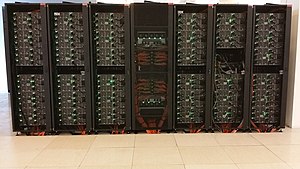 | |
| Active | operational 2015 |
|---|---|
| Sponsors | Ministry of Education, Universities and Research (Italy), Istituto Nazionale di Fisica Nucleare, University of Milano-Bicocca |
| Operators | The Members of the Consortium |
| Location | Cineca, Casalecchio di Reno, Italy |
| Architecture | IBM NeXtScale Infiniband with 4x QDR switches 2 8-cores Intel Haswell 2.40 GHz per node 16 cores/node,516 nodes, 8256 cores in total 2 Intel Phi 7120p per node on 384 nodes (768 in total); 2 NVIDIA K80 per node on 40 nodes (80 in total, 20 available for scientific research) |
| Power | 2,825.55 KW |
| Operating system | CentOS 7.0 |
| Memory | 128 GB/node, 8 GB/core; 46,592 GB |
| Storage | 2.000 TB of local scratch |
| Speed | 1,103.1 PFLOPS |
| Ranking | TOP500: 130, 2015-11 |
| Purpose | computational fluid dynamics, material and life science, and geophysics |
| Website | www |

Galileo is a 1.1 petaFLOPS supercomputer located at CINECA in Bologna, Italy.
History
GALILEO is available in Cineca since January 2015, in full production since February, the 2-nd, sponsored by the Ministry of Education, Universities and Research (Italy), the Istituto Nazionale di Fisica Nucleare and the University of Milano-Bicocca. It is the Italian National Tier-1 HPC machine, devoted to scientific computing as well as technical oriented applications. Galileo is also available to European researchers as a Tier-1 system of the PRACE infrastructure.
In June 2015, Galileo reached the 105-th position on the TOP500 list of fastest supercomputers in the world.
In the Green500 list of top supercomputers. Galileo reached the 389-th position in their benchmark, the system tested at 242.17 MFLOPS/W (Performance per watt).
Technical details
Galileo is an IBM Linux infiniband cluster, with a NeXtScale architecture. It is made of 516 compute nodes. Each node contains 2x8-cores Intel Haswell processors (2.40 GHz) and a shared memory of 128 GB. The internal network is Infiniband with 4xQDR switches. The cluster is accessible though 8 login nodes, also user for visualization, reachable via ssh at the address login.galileo.cineca.it. The login nodes are equipped with 2 nVidia K40 GPU each. On the cluster there are also 8 service nodes NX360M5 for I/O and management. The Operating system for both executable and login nodes is CentOS 7.0.
Galileo is an heterogeneous hybrid cluster: 359 nodes are equipped with Intel accelerators (Intel Phi 7120p), 2 accelerators per node for a total of 768 Phi in the system; 40 nodes are equipped with nVidia accelerators (nVidia K80), 2 accelerators per node for a total of 80 K80 in the system.
See also
References
- "Consortium of universities". Retrieved 9 March 2016.
- "Nov 2015". TOP500. Archived from the original on 7 April 2016. Retrieved 9 March 2016.
- "PRACE".
- "GALILEO". TOP500. Retrieved 9 March 2016.
- "The Green 500 List: November 2015". Graph 500. Archived from the original on 21 October 2016. Retrieved 9 March 2016.
External links
- La Repubblica in Italian
- Corriere Comunicazioni in Italian
- ResearchItaly Archived 3 April 2016 at the Wayback Machine in Italian
- Primeur Magazine Archived 3 April 2016 at the Wayback Machine
- RaiNews in Italian